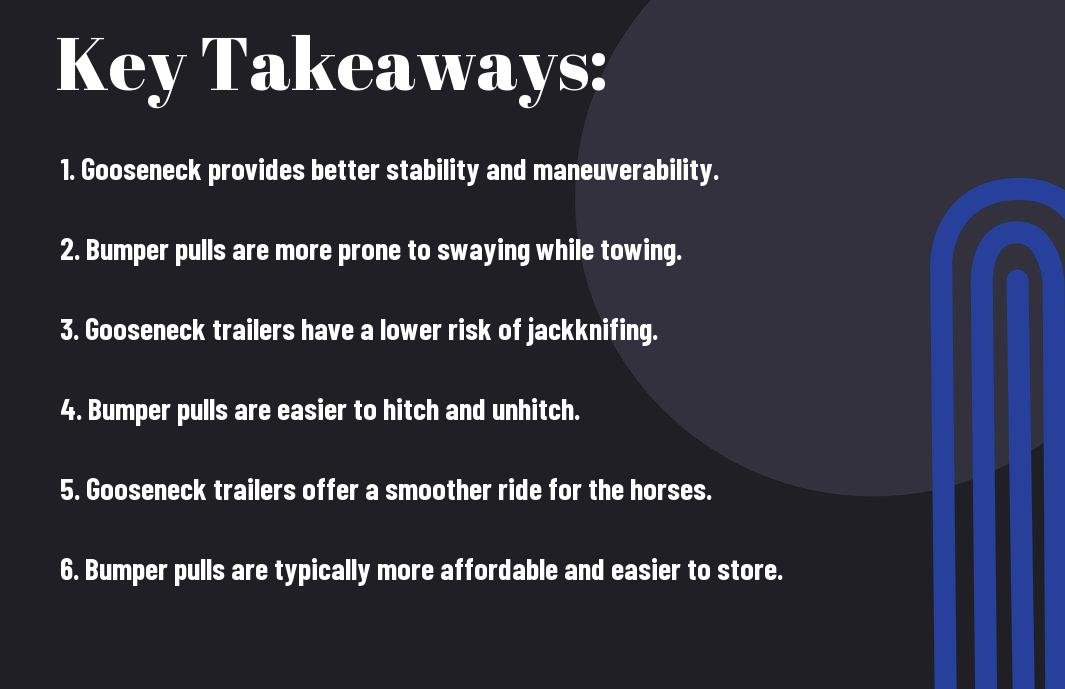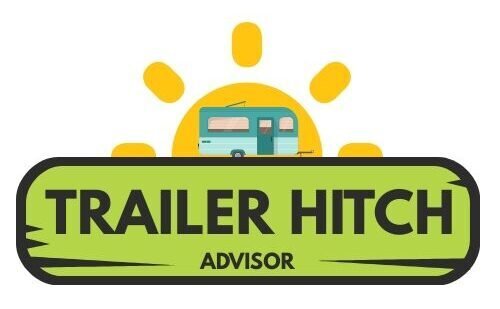When it comes to towing your trailer, safety should be your top priority. The decision between a gooseneck and a bumper pull can greatly impact the safety of both you and your cargo. It’s important to understand the key differences between the two options and how they can affect your towing experience. The gooseneck trailer offers several safety advantages over the bumper pull that you should consider before making a decision. From stability and control to weight distribution and reduced sway, the gooseneck design may provide a safer towing experience for you. Understanding these crucial differences is essential in making an informed decision that will prioritize your safety on the road.
Key Takeaways:
- Gooseneck trailers have better stability: Due to their design, gooseneck trailers have higher stability and are less prone to sway compared to bumper pull trailers.
- Gooseneck trailers can handle higher loads: Gooseneck trailers can handle heavier loads compared to bumper pull trailers, making them a safer option for transporting larger equipment or goods.
- Gooseneck trailers offer better towing experience: With their unique design, gooseneck trailers provide a smoother and more controlled towing experience, especially when navigating tight turns or rough terrain.
- Gooseneck trailers are less susceptible to jackknife accidents: Their attachment point over the rear axle of the towing vehicle makes gooseneck trailers less likely to jackknife compared to bumper pull trailers.
- Bumper pull trailers are more prone to sway: Bumper pull trailers are more likely to experience sway, especially at higher speeds or in windy conditions, potentially making them less safe than gooseneck trailers.
- Bumper pull trailers are more compatible with a wider range of vehicles: While gooseneck trailers offer better stability and handling, bumper pull trailers may be a more practical option for towing with a wider range of vehicles such as SUVs and pickup trucks.
- Proper towing technique and maintenance are crucial for safety: Regardless of the trailer type, proper towing technique, regular maintenance, and adherence to weight limits are essential for ensuring safe and secure towing experiences.

Understanding Gooseneck Trailers
Some trailers are designed to be pulled by a hitch in the bed of a pickup truck known as a gooseneck trailer. These trailers are commonly used for hauling livestock, horses, and other heavy loads. In this chapter, we will take a closer look at the design characteristics, as well as the pros and cons of gooseneck trailers to help you understand if they are safer than bumper pull trailers.
Design Characteristics
Gooseneck trailers are designed with a specialized hitch that attaches in the bed of a pickup truck, providing better stability and maneuverability. This type of hitch distributes the weight of the trailer more evenly between the front and rear axles of the towing vehicle, allowing for better control and handling on the road. Additionally, gooseneck trailers often have a more compact design, which can make them easier to maneuver in tight spaces compared to bumper pull trailers.
Pros and Cons
When considering the safety of gooseneck trailers, it’s important to weigh the pros and cons to make an informed decision. Below is a breakdown of the key advantages and disadvantages of gooseneck trailers:
| Pros | Cons |
| Greater stability and control while towing | Requires a specific type of hitch and towing vehicle |
| Ability to tow heavier loads | Higher upfront cost compared to bumper pull trailers |
| Better weight distribution between towing vehicle and trailer | Less flexibility in maneuvering in tight spaces |
| Reduced risk of trailer sway | Less common hitch type, may be harder to find repair services |
| Improved braking and handling | Requires larger and more powerful towing vehicle |
As you consider the design characteristics, pros, and cons of gooseneck trailers, it’s important to evaluate how these factors align with your specific towing needs and preferences.
Understanding Bumper Pull Trailers
Despite the rise in popularity of gooseneck trailers, bumper pull trailers remain a common choice for many horse owners and livestock haulers. Before comparing the safety of gooseneck and bumper pull trailers, it’s important to understand the design characteristics and pros and cons of bumper pull trailers.
Design Characteristics
When it comes to bumper pull trailers, they are designed to be towed by a hitch connected to the bumper or frame of the towing vehicle. This design places the weight of the trailer behind the rear axle of the towing vehicle, which can affect the vehicle’s handling and stability. Additionally, bumper pull trailers typically have a single axle, which can make them more prone to swaying while being towed.
Pros and Cons
When considering the pros and cons of bumper pull trailers, it’s important to weigh both the advantages and disadvantages before making a decision on which type of trailer to invest in. Below is a breakdown of the pros and cons of bumper pull trailers:
Pros
| 1. Maneuverability for tight spaces |
| 2. Lower upfront cost |
| 3. Less impact on towing vehicle’s payload capacity |
| 4. Easier to hook up and disconnect |
Cons
| 1. Potential for swaying while towing |
| 2. Limited stability, especially at higher speeds |
| 3. Increased risk of jackknifing |
| 4. Higher likelihood of trailer whip |
When using a bumper pull trailer, it’s important to be aware of the potential for swaying, which can pose a danger to you and your livestock. Additionally, the increased risk of jackknifing and trailer whip can have serious consequences, making it crucial to consider the safety implications of choosing a bumper pull trailer.
Safety Comparisons
To truly determine which type of trailer is safer, it is important to compare gooseneck and bumper pull trailers in terms of hitching and stability, as well as accident statistics and prevention. Here is a breakdown of these important factors:
Hitching and Stability
When it comes to hitching and stability, gooseneck trailers have a clear advantage over bumper pull trailers. The gooseneck hitch attachment is located in the bed of the truck, which provides a more stable and secure connection compared to the bumper pull hitch, which is attached to the vehicle’s bumper. This means that when you are towing a gooseneck trailer, you can expect less swaying and bouncing on the road, resulting in a more stable and controlled towing experience.
Accident Statistics and Prevention
When it comes to accident statistics and prevention, it has been found that gooseneck trailers are generally safer than bumper pull trailers. Gooseneck trailers are less prone to trailer sway, which can lead to accidents, especially at high speeds or in adverse weather conditions. Additionally, the placement of the gooseneck hitch in the bed of the truck provides a more direct and secure connection, reducing the risk of detachment and potential accidents on the road. By choosing a gooseneck trailer, you are reducing the likelihood of accidents and ensuring a safer towing experience.
Expert and User Experiences
Not sure if gooseneck trailers are safer than bumper pulls? Let’s take a look at what the experts and users have to say about their experiences with both types of trailers.
Consumer Reports
According to consumer reports, gooseneck trailers are generally considered safer than bumper pulls. The main reason for this is the stability and control that a gooseneck trailer offers. With the hitch point positioned over the rear axle of the towing vehicle, gooseneck trailers are less prone to swaying and jackknifing, especially during sudden stops or sharp turns. This can provide you with added peace of mind when hauling heavy loads or traveling on windy roads.
Professional Recommendations
Professionals in the industry also tend to recommend gooseneck trailers over bumper pulls for their safety advantages. The design of a gooseneck trailer distributes weight more evenly between the tow vehicle and the trailer, leading to improved stability and control while towing. This can be especially important for long hauls or when navigating challenging terrain. Additionally, the connection point of a gooseneck trailer allows for a tighter turning radius, making it easier to maneuver in tight spaces.
Is Gooseneck Safer Than Bumper Pull?
Drawing together all the information we have discussed, it is clear that in many cases, a gooseneck trailer can be safer than a traditional bumper pull. The design and attachment point of a gooseneck trailer provide better stability and maneuverability, which can result in a safer towing experience for you and your passengers. Additionally, the weight distribution and handling characteristics of a gooseneck trailer can contribute to a more secure and controlled towing experience. While both types of trailers have their advantages, it is important to carefully consider your specific towing needs and preferences in order to determine which option is best for you. Ultimately, the safety of your trailer choice will depend on proper maintenance, driver experience, and adherence to safe towing practices.
FAQ
Q: Is a gooseneck trailer safer than a bumper pull?
A: While both types of trailers have their own safety features, gooseneck trailers are generally considered safer due to their stability and weight distribution. The gooseneck hitch is located in the bed of the truck, which provides better stability and control, especially when towing heavier loads.
Q: What are the safety benefits of a gooseneck trailer?
A: Gooseneck trailers are known for their stability, especially when towing heavy loads. The gooseneck hitch is situated in the bed of the truck, which helps evenly distribute the weight of the trailer and provides better control and handling on the road.
Q: Are there any disadvantages to using a gooseneck trailer?
A: One potential disadvantage of gooseneck trailers is that they require a specialized hitch installed in the bed of the truck, which may limit the use of the truck bed for other purposes. Additionally, gooseneck trailers are generally more expensive than bumper pull trailers.
Q: What are the safety considerations when towing with a gooseneck trailer?
A: When towing with a gooseneck trailer, it is important to ensure that the hitch is securely locked into place in the bed of the truck. Proper weight distribution and load balancing are also crucial for safe towing. Regular maintenance of the trailer and truck, including brakes and tires, is essential for safe towing with a gooseneck trailer.
Q: How do I know if a gooseneck trailer is the right choice for me?
A: If you frequently tow heavy loads, such as livestock or construction equipment, a gooseneck trailer may be the safer and more practical choice for you. However, it is important to consider the specific towing needs, vehicle capabilities, and budget before making a decision.
